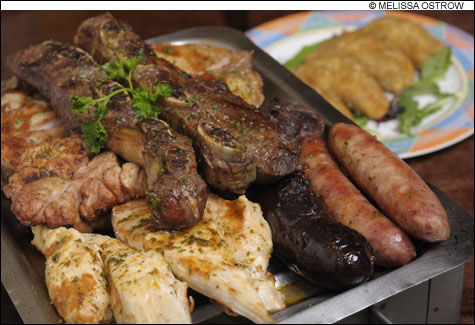
CARNIVORE’S DELIGHT: Parrillada is an Argentine passion. |
| Tango | 781.443.9000 | 464 Mass Ave, Arlington | Open Sun–Thurs, 5–10 pm; and Fri & Sat, 5–11 pm | AE, DI, MC, VI | Beer and wine | No valet parking | Sidewalk-level access; crowded tables |
It's not fair to review Greater Boston's only Argentine restaurant right after spending two delicious weeks in Buenos Aires, but it is revealing. One revelation? Some of the most nostalgic treats — or at least the way they're prepared — at Tango have actually gone out of fashion in Argentina.For example, no food would be more important to an Argentine in the wrong hemisphere than empanadas, the turnovers — like Cornish pasties with Latin soul — that are the source of endless discussion back home. The empanada de carne ($2.60) at Tango is pretty close to some of the really fantastic ones we sampled on our trip. But, like most empanadas of decades past, it's deep-fried with flaky pastry. The current trend in Buenos Aires is baked empanadas; we didn't have a single one there that was deep-fried. The typical filling is chopped meat, olives, and raisins; the result is sweet and salty. (The other traditionally popular one is all vegetables, which Tango also has, along with chicken.)
Pizza, ubiquitous in Buenos Aires, has largely driven out two melted-cheese appetizers there, but both are still served in cast-iron bowls at Tango (and both excellent). Provoleta a la parrilla ($9.25) is grilled provolone you can roll onto your fork like spaghetti. Pimientos rojas y verdes ($9.50) mixes roasted red and green peppers with similarly melted mozzarella, a less striking cheese. The soup of the day ($6.75) was a hearty lentil, with spice in the beginning of the flavor and hot pepper on the finish — good enough for a Patagonian winter.

Argentines sometimes neglect vegetables, though there's a wonderful variety in their markets. At Tango, don't miss the ensalada verde with "exquisite dressing" ($6.75), which is the same brown dressing as on the ensalada mixta ($7.50), except that the one on the latter is not so sweet and, well, less exquisite. Ensalada de palmitos con salsa golf ($9.75) features canned hearts of palm, just as it does under the Southern Cross. Salsa golf is a mixture of mayonnaise, ketchup, and mustard, invented at the "Golf Club" by Dr. Luis Leloir when he was still a medical student, long before his 1970 Nobel Prize for chemistry. It didn't figure in his prize, but Leloir apparently often joked that he should have patented it to support his other work. Tango just adds a decorative squirt.
Matambre, which means "hunger killer," is a poached roll of meat around eggs and vegetables. In Argentina now it's almost always made with veal, which Tango has, but the restaurant also offers the older form using flank steak ($9.25) with carrots inside and two creamy sauces on top. An appetizer is, of course, the opposite of hunger killer, but this is tasty enough to ignore the contradiction.
Another Argentine food passion is parrillada ($29/for one; $39/for two), a very slow barbecue of various pieces of beef and sausages, sometimes extended to butternut-squash slices these days. The long cooking makes the meat tender and helps it develop considerable flavor, especially in the short ribs, which are the quintessential ingredient. Tango's version has them, though they're a tougher and faster-cooked American-beef variety. So your highlight might be the pork sausage, an excellent match for the low-spice Argentine chorizo, or sweetbreads, which are always tender and delicious. The beef kidneys are chewier. And the morcilla (blood sausage) at Tango have a bit of allspice, like the Portuguese-American kind, instead of sage like the Argentine blood sausage. Tango sends the whole shebang to the table on a portable charcoal grill; it set off the fire alarm as we were leaving. They round out the grill with a nice pork chop and boneless chicken breast. Sauce isn't important in Argentine barbecue, but the default chimichurri of olive oil, parsley, and hot pepper is on every table.
The accompanying vegetable is potato rounds cut about three times as thick as a potato chip and deep-fried to fabulousness. (Don't miss these with any other entrûe, with which you get two side dishes.) A special on rack of lamb ($23.95) was three double chops with a raspberry glaze, plus side dishes of Creole rice and cheese-stuffed zucchini. The lamb was really excellent, as it so often is in steak houses. My other favorite side dishes were winter squash mashed with potatoes, and mixed sautûed vegetables, ordered with a Milanesa a la Napolitana ($19.95), which I'd describe as midway between Wiener schnitzel and chicken-fried steak.
The wine list at Tango is a real glory: page after page of malbecs at all levels, from easygoing fruit bombs to substantial riservas at 14 percent alcohol. We chose a 2006 La Posta Malbec "Angel Paulucci Vineyard" ($42), a mid-range malbec with the intense fruit of the light ones, but some oak to give it vanilla undertones and weight. If by any chance you want white wine, there are a couple of unusual ones from the Argentine torrontûs grape. Coffee ($2.50) and decaf ($2.50) were weak but clean; a decaf cappuccino ($4.50) was burnt.